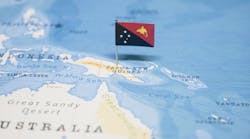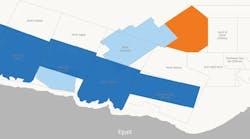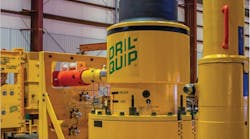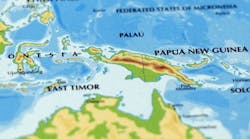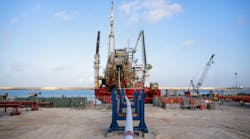Bruce Beaubouef • Houston
Moratorium takes toll on deepwater Gulf of Mexico
Given recent events, it is not surprising that offshore drilling in the Gulf of Mexico (GoM) is down across the board, in shallow, medium, and deep waters. The results are due in no small part to the deepwater drilling moratorium issued by the federal government in the wake of theDeepwater Horizon oil spill, effectively shutting down exploratory operations on the outer continental shelf. The moratorium, issued in early May, brought a halt to work on 33 exploratory wells in the deepwater Gulf of Mexico, and instituted a six-month suspension on all drilling in water depths greater than 500 ft.
Data provided by Dodson Data Systems toOffshore show that the number of wells drilled in all water depths has declined over the previous year: from 213 total in 2009 to 143 through July 2010 for shallow water (600 ft or less); from 23 total in 2009 to 12 through July 2010 for medium water depths (600 ft to 3,000 ft); and from 80 total in 2009 to 41 through July 2010 in deepwater (3,000 ft or more).
Interestingly, the declining number of wells drilled in the GoM is part of a larger decline that has been ongoing over the past three years, for all water depths. The total number of wells drilled fell from 515 in 2007 to 316 in 2009, and were 196 total in 2010, through July.
US Gulf of Mexico, wells drilled 2007 - 2010/07 YTD, by year/month drilled and water depth range
Yet, before theDeepwater Horizon, 2010 was on pace to be a good year for deepwater drilling in the GoM. By May – when the moratorium took effect – 41 wells had been drilled, more than half the 2009 total of 80 deepwater wells drilled, in less than half of the year. It remains to be seen how and when deepwater drilling operations will resume following the end of the moratorium.
In general, the moratorium has placed a cloud of gloom and uncertainty over offshore drilling in the Gulf and the regional economy. Fear of new rules and regulations has already led many drillers to slow their exploration plans in the GoM, and some energy analysts have said the hesitation could last longer than the six-month suspension imposed by the moratorium.
Moreover, the moratorium, while focused on deepwater drilling, may be having a chilling effect on shallow-water drilling as well. Don G. Briggs, president of the Louisiana Oil & Gas Association, contends that there is also a “de facto moratorium” on shallow-water drilling in the GoM. While the Department of Interior points out that only deepwater drilling is affected, the federal government has granted only four permits for shallow-water drilling in the past four months, Briggs points out.
The National Ocean Industries Association (NOIA) says that preliminary estimates show that the suspension will result in significant job loss and adverse economic impact. The Louisiana Mid-Continent Oil and Gas Association (LMOGA) says that for each platform idled by the work stoppage, up to 1,400 jobs are at risk, and lost wages could reach $10 million per month per platform, and up to $330 million per month for all 33 platforms.
The LMOGA estimates that a six-month suspension could defer 4% of anticipated 2011 deepwater Gulf of Mexico production (80,000 b/d of oil), and likely render seven current discoveries sub-economic, putting $7.6 billion in future government revenues at risk. Additionally, drilling rigs idled by the order eventually could be contracted overseas, and be unavailable to work in the Gulf once the halt is lifted, thus making the U.S. even more dependent on foreign oil.
Since deepwater regions generate 80% of the Gulf’s oil production and 45% of its natural gas production, a six-month suspension ending in late November can be expected to have “severe and perhaps long lasting impacts on domestic energy supply and economic security,” says Burt Adams, NOIA chairman.
The offshore industry is responsible for nearly 200,000 jobs in the Gulf of Mexico alone, and provides 30% of the nation’s domestic oil production and 11% of its domestic gas production. In addition, offshore oil and gas production accounts for an average $13 billion a year in non-tax revenues to states and the federal government, and the industry has made over $24 billion available to the Land and Water Conservation Fund over the last 28 years.
Throughout the first half of 2010, the five leading operators in the Gulf (including federal OCS and state acreage) in terms of wells drilled included Chevron, with 23 wells drilled through July; Apache, with 16 wells; Arena Energy with 15; Shell E&P with 11; and Anadarko with nine wells drilled.
There are those who remain optimistic about the deepwater Gulf. Recently, Carl Scharpf, Gulf Coast Exploration & New Ventures manager for Apache Corp., said that the deepwater Gulf of Mexico remains a promising exploration venue for the company. Speaking at the NAPE E&P Conference, Scharpf pointed to Apache’s aggressive entry into deepwater GoM by noting that although the company is relatively new to the arena, it already holds 100 deepwater blocks. While there are significant remaining reserves in the GoM, it is the improved exploration technologies that make the future bright, Scharpf said. Wide-azimuth seismic surveys and improved processing are among the leaders in the trend.
Other operators have remained active in the shallow-water Gulf, despite a possible chilling effect. McMoRan Exploration Co. recently announced indications of potential hydrocarbon-bearing zones at the Blueberry Hill deep gas side track, and in-progress drilling at the Davy Jones and Blackbeard East ultra-deep prospects offshore Louisiana.
Going forward, industry observers say they expect to see increased regulations and safety procedures imposed on deepwater drilling. These new regulations will require increased vendor involvement, for both services and equipment. It will also manifest itself through an increased demand for higher specifications and more robust equipment, all of which will benefit the large oilfield service companies and the makers of the required specialized equipment.
Offshore Articles Archives
View Oil and Gas Articles on PennEnergy.com


